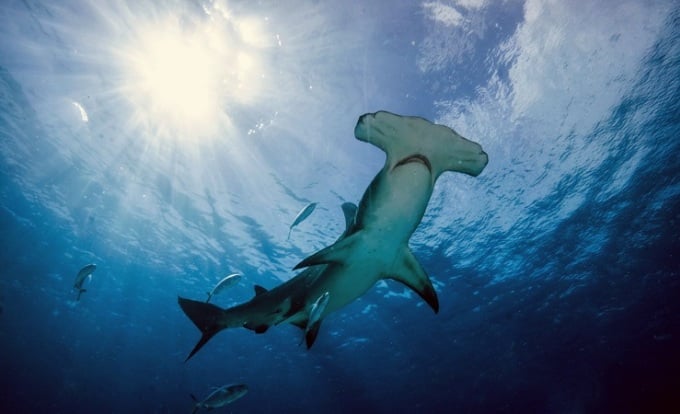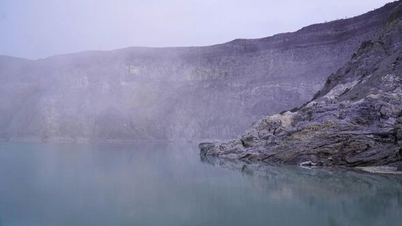A breath-holding tactic helps hammerhead sharks withstand freezing temperatures while hunting at depths of nearly a kilometer below the ocean's surface.

Hammerhead sharks hunt at great depths. Photo: Earth
Hammerhead sharks can hold their breath when diving into freezing waters. A study published on May 12 in the journal Science reveals that this tactic allows the warm-water fish to regulate their temperature while hunting. Mark Royer, a shark biologist at the University of Hawaii who led the study, said the technique was a complete surprise to him and his colleagues. This type of behavior has never been observed in any other deep-diving fish, and raises questions about how common breath-holding behavior is in other species.
The critically endangered hammerhead shark normally relies on forward motion to push water over its gills, allowing it to filter the oxygen it needs to breathe. However, when hammerhead sharks swim as deep as 800 meters to catch squid and other prey, the colder water can affect their metabolism, cardiovascular function, and vision, all of which reduce their ability to hunt.
By closing their gills and mouths to hold their breath, hammerhead sharks can limit their exposure to cold water. Some species, such as bluefin tuna and mako sharks, have special body structures that allow them to conserve body heat in cold water, but hammerhead sharks don’t have that advantage. That’s why some scientists theorize that hammerhead sharks maintain their body heat through simple thermal inertia, relying on their large body size to maintain temperature and carry heat with them when they dive into cold deep waters. However, the small sensors the team placed on an adult hammerhead shark suggest that thermal inertia isn’t the reason they stay warm during their deep-sea hunts.
In the study, Royer’s team analyzed detailed information about the swimming behavior, depth, and location of a group of six tagged male sharks. In total, they made more than 100 dives around Hawaii over several weeks. Sensors also recorded their muscle temperatures during these repeated night dives. Combined with modeling, the data showed that the sharks maintained their body temperatures both when they were at the surface, at around 80 degrees Fahrenheit, and when they dived deeper than 2,500 feet, where temperatures dropped to 5 degrees Fahrenheit.
The sharks’ body temperatures actually drop as they swim uphill, and halfway back to the surface, they open their gills to take in the oxygen they need. That’s not what the team predicted with thermal inertia. While they haven’t observed sharks actually closing their gills, they suspect that’s what’s happening. To confirm the breath-holding hypothesis, Rogers and his colleagues will need to attach cameras to hammerhead sharks’ pectoral fins to watch the gills open and close as the sharks dive.
The researchers are still unsure how the 12-foot-long sharks learn to hold their breath. Royer says they may learn from social interactions with other hammerheads. Another piece of evidence supporting their theory is remotely operated vehicle footage of adult hammerheads swimming in Tanzania at depths of more than 3,000 feet with their gills closed. If hammerheads hold their breath while feeding in the deep sea, they may be able to withstand the low-oxygen environments that are increasingly common around the world . That could explain their survival in the oxygen-poor waters of the Gulf of California.
An Khang (According to National Geographic )
Source link



![[Photo] Panorama of the Opening Ceremony of the 43rd Nhan Dan Newspaper National Table Tennis Championship](https://vphoto.vietnam.vn/thumb/1200x675/vietnam/resource/IMAGE/2025/5/19/5e22950340b941309280448198bcf1d9)
![[Photo] General Secretary To Lam attends the conference to review 10 years of implementing Directive No. 05 of the Politburo and evaluate the results of implementing Regulation No. 09 of the Central Public Security Party Committee.](https://vphoto.vietnam.vn/thumb/1200x675/vietnam/resource/IMAGE/2025/5/19/2f44458c655a4403acd7929dbbfa5039)
![[Photo] Close-up of Tang Long Bridge, Thu Duc City after repairing rutting](https://vphoto.vietnam.vn/thumb/1200x675/vietnam/resource/IMAGE/2025/5/19/086736d9d11f43198f5bd8d78df9bd41)

![[Photo] President Luong Cuong presents the 40-year Party membership badge to Chief of the Office of the President Le Khanh Hai](https://vphoto.vietnam.vn/thumb/1200x675/vietnam/resource/IMAGE/2025/5/19/a22bc55dd7bf4a2ab7e3958d32282c15)

















![[Photo] Prime Minister Pham Minh Chinh inspects the progress of the National Exhibition and Fair Center project](https://vphoto.vietnam.vn/thumb/1200x675/vietnam/resource/IMAGE/2025/5/19/35189ac8807140d897ad2b7d2583fbae)































































![[VIDEO] - Enhancing the value of Quang Nam OCOP products through trade connections](https://vphoto.vietnam.vn/thumb/402x226/vietnam/resource/IMAGE/2025/5/17/5be5b5fff1f14914986fad159097a677)



Comment (0)